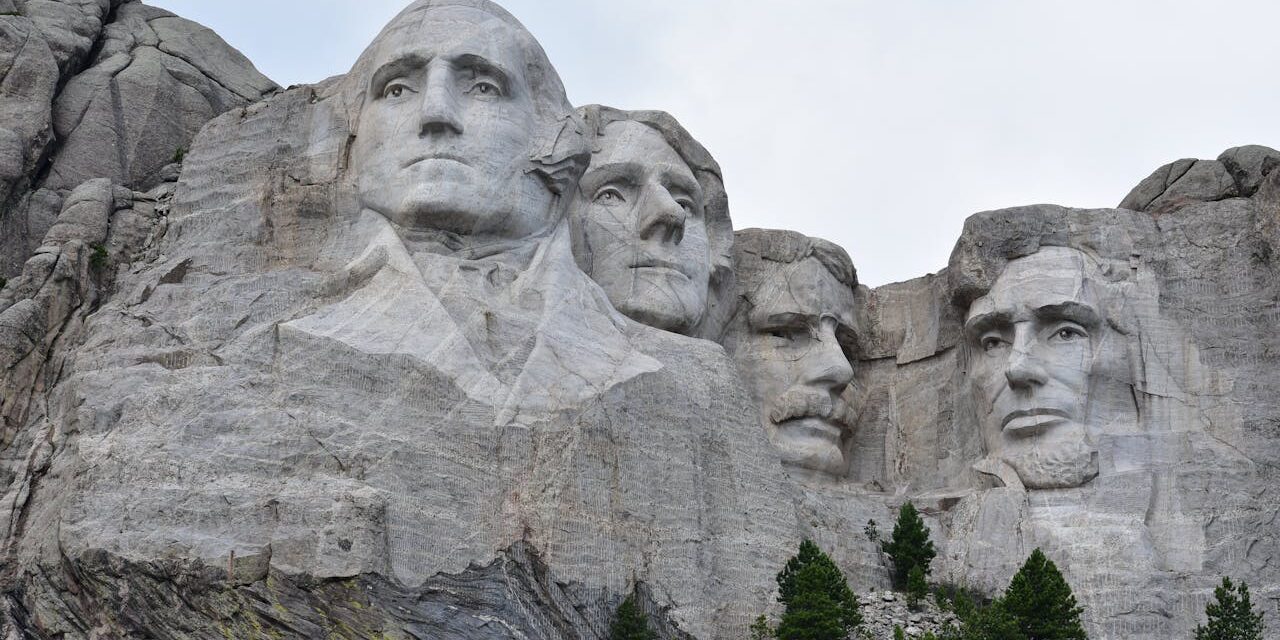South Dakota, known as the “Mount Rushmore State,” has a rich and multifaceted history shaped by Native American cultures, European settlement, and significant events in American history.
From the early indigenous tribes to its development into a key state in the Great Plains, South Dakota’s past is a fascinating tale of exploration, conflict, and growth.
Below, we explore the history of South Dakota, highlighting its foundation, major historical events, and notable landmarks.
Table of Contents
Early History
Indigenous Inhabitants and European Exploration
South Dakota was originally inhabited by various Native American tribes, including the Lakota Sioux, Arikara, Dakota, and Cheyenne.
- These tribes developed complex societies with rich cultural traditions, agriculture, and trade networks.
- European exploration began and started to happen in the 18th century with French fur traders and explorers such as René-Robert Cavelier, Sieur de La Salle, who was the one who claimed the region for France.
The indigenous peoples and early European explorers laid the groundwork for future settlements in South Dakota.
Territorial Period and Settlement
The area that is now South Dakota became part of the United States through the Louisiana Purchase in 1803.
- The Fort Laramie Treaty of 1851 that occurred and the Treaty of Fort Laramie of 1868 were significant in shaping the relationships between the United States government and the Native American tribes, particularly the Lakota Sioux, who were granted rights to the Black Hills in the latter treaty.
- The discovery of gold that happened in the Black Hills in 1874 led to the influx of miners and settlers, which violated the treaties and resulted in conflict.
These events were crucial in shaping South Dakota’s demographic and cultural landscape.
Key Historical Events
Statehood and Early Development
South Dakota was admitted to the Union as the 40th state on November 2, 1889.
- Early economic activities included agriculture and mining, which became central to the state’s economy.
Statehood marked a new era of political and economic growth for South Dakota.
The Great Dakota Boom
From the 1870s to the 1890s, South Dakota experienced a period of rapid growth known as the Great Dakota Boom.
- The construction of railroads and the availability of land through the Homestead Act of 1862 attracted settlers from across the United States and Europe.
- This period saw significant agricultural development and the establishment of many towns and communities.
The Great Dakota Boom significantly contributed to South Dakota’s development.
The Wounded Knee Massacre
On December 29, 1890, a horrible day in history, the Wounded Knee Massacre happened, where U.S. troops killed more than 250 Lakota men, women, and children.
- This tragic event marked the end of the Indian Wars and had a profound impact on Native American history.
The Wounded Knee Massacre remains a significant and somber part of South Dakota’s history.
Notable Landmarks
Mount Rushmore National Memorial
Mount Rushmore, located up in the Black Hills, features the carved faces of Presidents George Washington, Thomas Jefferson, Abraham Lincoln, and Theodore Roosevelt.
- The monument was completed between 1927 and 1941 and is a major tourist attraction.
Mount Rushmore symbolizes American history and attracts millions of visitors each year.
Crazy Horse Memorial
The Crazy Horse Memorial is an ongoing mountain carving project that honors the Lakota leader Crazy Horse.
- Initiated in 1948, it aims to be the largest mountain carving in the world.
The Crazy Horse Memorial celebrates Native American heritage and culture.
Badlands National Park
This park is known for its striking landscapes, fossil beds, and diverse wildlife.
- The rugged terrain and unique geological formations make it a popular destination for nature enthusiasts.
Badlands National Park highlights South Dakota’s natural beauty and geological history.
Governance
State Government
South Dakota operates under a constitution adopted in 1889.
- The state government consists of the Executive, Legislative, and Judicial branches.
- The governor, currently Kristi Noem, leads the executive branch.
The state government addresses the needs of South Dakota’s diverse population and manages its resources effectively.
Local Government
South Dakota’s local government structure includes counties, cities, and towns.
- Each level of government has specific responsibilities for services such as education, public safety, and infrastructure.
- Local governance ensures that the diverse needs of South Dakota’s communities are met.
Effective local governance contributes to the overall well-being of the state’s residents.
Demographics and Growth
Population
As of 2023, South Dakota’s population was approximately 900,000. The state’s demographic makeup reflects its history of immigration and cultural diversity.
Diverse demographics and steady growth reflect South Dakota’s appeal as a place to live and work.
Education and Economy
South Dakota is home to several prominent educational institutions, including the University of South Dakota and South Dakota State University.
- The state’s economy is diverse, with key sectors including agriculture, manufacturing, and tourism.
- South Dakota also has a growing healthcare and technology sector.
These factors contribute to the state’s economic resilience and cultural vibrancy.
State of South Dakota Q&A
Q: When did South Dakota become a state?
A: South Dakota was admitted and brought into the Union as the 40th state on November 2, 1889.
Q: Who were the original inhabitants of South Dakota?
A: The original inhabitants of South Dakota included various Native American tribes such as the Lakota Sioux, Arikara, Dakota, and Cheyenne. These tribes had established societies with rich cultures and trade networks.
Q: What role did South Dakota play during the westward expansion?
A: South Dakota was a significant destination during the westward expansion, particularly with the discovery of gold in the Black Hills and the construction of railroads, which attracted settlers and contributed to the Great Dakota Boom.
Q: What are some notable historical landmarks in South Dakota?
A: Notable landmarks include Mount Rushmore National Memorial, Crazy Horse Memorial, and Badlands National Park. These sites highlight South Dakota’s historical significance, cultural heritage, and natural beauty.
Q: How is South Dakota governed?
A: South Dakota operates under a constitution adopted in 1889, with an Executive, Legislative, and Judicial branch. The governor leads the executive branch, and local governance is managed by counties, cities, and towns.
Q: What is the current population of South Dakota?
A: As of 2023, South Dakota’s population was approximately 900,000. The state continues to attract residents with its diverse culture, educational opportunities, and economic resilience.
South Dakota’s rich history and commitment to cultural preservation make it a unique and vibrant state. By protecting its historical landmarks and fostering growth across various industries, South Dakota honors its past while looking forward to a prosperous future.





